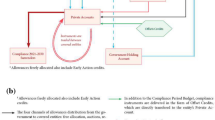Abstract
In permit trading systems, free initial allocation is common practice. A recent example is the European Union Greenhouse Gas Emission Trading Scheme (EU-ETS). We investigate effects of different free allocation schemes on incentives and identify significant perverse effects on abatement and output employing a simple multi-period model. Firms have incentives for strategic action if allocation in one period depends on their actions in previous ones and thus can be influenced by them. These findings play a major role where trading schemes become increasingly popular as environmental or resource use policy instruments. This is of particular relevance in the EU-ETS where the current period is a trial-period before the first commitment period of the Kyoto protocol. Finally, this paper fills a gap in the literature by establishing a consistent terminology for initial allocation.
Similar content being viewed by others
References
Åhman M, Burtraw D, Kruger J, Zetterberg L (2007) A ten-year rule to guide the allocation of EU emission allowances energy policy. Energy Policy 35(3):1718–1730
Åhman M, Holmgren K (2006) Harmonising allocation to new entrants in the nordic energy sectors, Working paper, The Swedish Environmental Research Institute IVL
Bergland H, Clark DJ, Perdersen PA (2002) Rent-seeking and quota regulation of a renewable resource. Resour Energy Econ 24(3):263–279
Burtraw D, Palmer K (2006) Compensation rules for climate policy in the electricity sector. Resources for the Future
Burtraw D, Palmer K, Bharvirkar R, Paul A (2001) The effect of allowance allocation on the cost of carbon emission trading. RFF Discussion Paper 01-30, August 2001, Resources for the Future, Washington DC
Burtraw D, Palmer K, Bharvirkar R, Paul A (2002) The effect on asset values of the allocation of carbon dioxide emission allowances. Electr J 15(5):51–62
Burtraw D, Kahn D, Palmer K (2006) CO2 allowance allocation in the regional greenhouse gas initiative and the effect on electricity investors. Electr J 19(2):79–90
Dewees DN (2001) Emissions trading: ERCs or allowances? Land Econ 77(4):513–526
Dijkstra B (1999) The political economy of environmental policy. Edward Elgar, Cheltenham
Egenhofer C, Fujiwara N, Åhman M, Zetterberg L (2006) The EU ETS: taking stock and looking ahead, ECP Report 2, May 2006
EPA (1990) Clean Air Act. U.S. Environmental Protection Agency. http://www.epa.gov/ttn/oarpg/gen/caa-pdf.Pdf (8.8.2006)
EU (1997) Council regulation (EC) No 1466/97 of July 1997 on the strengthening of the surveillance of budgetary positions and the surveillance and coordination of economic policies. http://eur-lex.europa.eu/smartapi/cgi/sga\_doc? smartapi! celexapi! prod! CELEXnumdoc \&lg=EN \&numdoc= 31997R1466 \&model= guichett (17.7.2006). See also ‘The stability and growth pact’, http://ec.europa.eu/economy_finance/about/activities/sgp/sgp_en.htm (17.7.2006)
EU (2003a) Directive 2003/87/EC of the European Parliament and of the Council of 13 October 2003 establishing a scheme for greenhouse gas emission allowance trading within the Community and amending Council Directive 96/61/EC. http://europa.eu.int/eur-lex/pri/en/oj/dat/2003/l275/l27520031025en00320046.pdf (29.4.2005)
EU (2003b) Implementation of the Stability and Growth Pact’, European Council – ECOFIN Meeting, 25 November 2003. http://www.eurotreaties.com/stabpactend.pdf (17.7.2006)
EU (2006) EU emissions trading scheme delivers first verified emissions data for installations. http://europa.eu/rapid/pressReleasesAction.do?reference=IP/06/612 (18.7.2006)
Euractiv (2006) CO2 quota plans: EU threatens legal action against latecomers. Euractiv EU News & Policy Positions. http://www.euractiv.com/en/sustainability/co2-quota- plans-eu- threatens-legal- action-latecomers/article-157019 (28.7.2006)
Feldstein M (2005) The Euro and the stability pact. Talk at the American Economic Association. http://www.nber.org/feldstein/eurostabilitypact.pdf (17.7.2006)
Fischer C (2001) Rebating environmental policy revenues: output-based allocations and tradable performance standards. RFF Working Papers 01-22, July 2001, Resources for the Future, Washington, DC
Fischer C (2003) Combining rate-based and cap-and-trade emissions policies. Climate Policy 3S2: S89–S109. Related RFF Discussion Paper: 03–32
Fischer C, Fox A (2004) Output-based allocations of emissions permits: efficiency and distributional effects in a general equilibrium setting with taxes and trade. RFF Discussion Paper 04-37, December 2004, Resources for the Future, Washington, DC
Fredriksson P, Sterner T (2005) The political economy of refunded emissions payments programs. Econ Lett 87(1):113–119
Gersbach H (2002) How to get firms to invest: a simple solution to the hold-up problem in regulation. Rev Econ Des 7(1):45–56
Gersbach H, Requate T (2004) Emission taxes and optimal refunding schemes. J Public Econ 88(3–4):713–725
Goulder L, Parry I, Williams III R, Burtraw D (1999) The cost-effectiveness of alternative instruments for environmental protection in a second-best setting. J Public Econ 72(3):275–288
Hahn RW (1989) Economic prescriptions for environmental problems: how the patient followed the doctor’s orders. J Econ Perspect 3:95–114
Haites E, Hornung R (1999) Analysis of options for gratis distribution of allowances. National Round Table on the Environment and the Economy, Canada
IEAT (2005) State and trends of the carbon market 2005. International Emissions Trading Association and World Bank, Washington, DC, May 2005
Joskow P, Schmalensee R (1998) The political economy of market-based environmental policy: the U.S. acid rain program. J Law Econ XLI: 37–83
Kolshus H, Torvanger A (2005) Analysis of EU member states’ national allocation plans. CICERO Working Paper 2005:2
Meyer MC, Sherman WL (1979) The course of mexican history. Oxford University Press, New York
Nordhaus W (2005) Life after kyoto: alternative approaches to global warming policies. NBER Working Paper Series WP 11889
Parry IWH, Williams III RC (1999) A second-best evaluation of eight policy instruments to reduce carbon emissions. Resour Energy Econ 21:347–373
Raymond L (2003) Private rights in public resources: equity and property allocation in market-based environmental policy. RFF Press, Washington, DC
Smith R (2006) Burning debate: as emission restrictions loom, texas utility bets big on coal. Wall Street Journal 26.7.2006
Sterner T (2003) Policy instruments for environmental and natural resource management. RFF Press, Washington, DC
Sterner T, Höglund Isaksson L (2006) Refunded emission payments theory, distribution of costs, and Swedish experience of NOx abatement. Ecological Economics 57(1):93–106
Svendsen GT, Daugbjerg C, Hjollund L, Pedersen AB (2001) Consumers, industrialists and the political economy of green taxation: CO2 taxation in the OECD. Energy Policy 29:489–497
Tietenberg T (2006) Emissions trading – principles and practice. RFF Press, Washington, DC
Author information
Authors and Affiliations
Corresponding author
Rights and permissions
About this article
Cite this article
Sterner, T., Muller, A. Output and abatement effects of allocation readjustment in permit trade. Climatic Change 86, 33–49 (2008). https://doi.org/10.1007/s10584-007-9281-0
Received:
Accepted:
Published:
Issue Date:
DOI: https://doi.org/10.1007/s10584-007-9281-0




